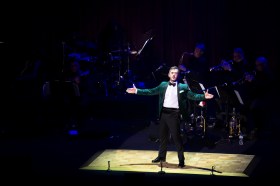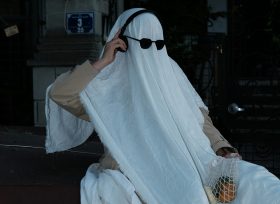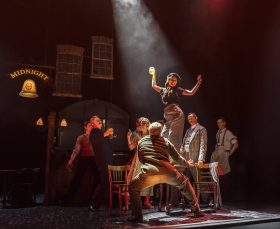In the aftermath of terrible disaster, art and artists often play a role in providing relief for trauma victims and survivors. Many of those that experienced Hurricane Katrina, the Asian Tsunami of 2004, the 2005 London Bombings, and the World Trade Center attacks of September 11, 2001, have found some solace through culture and creativity – and there are plenty of organizations out there to assist them in both the short and long-term.
As the crisis in the Middle East continues, art is making an unexpected appearance on the frontline. The caring for hundreds and thousands of internally displaced people in Southern Lebanon has fallen to the country’s volunteer organizations, and among those artists groups, like The SHAMS Arts Collective, have been leading the way. Founder of the collective, theater practitioner Roger Assaf, says he wanted to establish a ‘third space’ which was neither “the ideological and war-mongering thesis of Hizbullah”, nor “the irresponsible rhetoric of Arab oil merchants or Lebanese billionaires”, but was condemning of “the crimes of the theocratic state of Israel … and the complicity of Europe.” Politics aside, the organization has been actively filling a humanitarian need.
But the role of art in crisis in not a new phenomenon. An exhibition entitled How to Survive an Earthquake (held in San Francisco earlier this year), showed art and artists on the ground after the earthquake and fire that killed 3,000 in April 1906. The exhibit showcases photographs, letters and newspaper clippings that document the lives of its inhabitants weeks and months following the disaster. Artists were among the first to consciously return, providing comedy acts and theatre shows, rekindling the spirit of the city’s thriving arts and entertainment scene prior to the tragedy and helping survivors keep on.
To commemorate the first anniversary of the 2004 tsunami that devastated Asia, a sculpture exhibition entitled Art on The Beach was held on Phuket’s Patong Beach, transforming the site into an art gallery with artwork by 30 international and Thai artists. This space provided not only emotional healing, but was also practically helpful, generating an income for the local communities by attracting tourists.
And three weeks after the tsunami hit the Southern coasts, renowned Thai artists visited the affected areas, keen to help relieve the victims’ pain and assist in any way they could.
Professor Apinan Poshyananda, director-general of the Ministry of Culture’s Office of Contemporary Art and Culture, told The Bangkok Post that art and culture were able to heal many souls after the trauma.
“At that time, many of the tsunami victims were not physically or mentally ready to take part in any art project. They were simply too devastated,” said Poshyananda. But over time, he explained, people were able to transform their grief “from something negative to something creative and hopeful.”
Other post-tsunami activities included an artistic camp for children featuring workshops in batik design, film-making and more.
Similarly, Makhampom Theatre Group, a grassroots community theatre organization has been actively working in tsunami-affected communities.
Makhampom provided relief support and a mini-performance tour not long after the tsunami struck. They are currently working alongside charity organizations such as the Children’s Foundation and Save the Children to develop a program involving theatre workshops which focus on “trauma relief and healing”.
National Museums and Galleries of Wales took a longer-term approach, organizing an exhibit of artwork by Sri-Lankan child survivors of the tsunami. Funds raised from the eventual sale of artwork will be divided between the child artists, schools and an orphanage in north east Sri Lanka.
Memorials have also played a significant role towards healing in the lives ravaged by trauma. For victims of the terrorist attacks on September 11, 2001 and the bombings in London, they have had special significance. ArtAID, an organization that provides a space for artists to support charitable causes, sponsored the creation of the FDNY Angel Memorial as tribute to the firefighters who responded to the World Trade Center attacks on September 11. The memorial also acts to console families and friends of those were killed in the tragedy. After the 2005 London bombings ArtAID launched the “United In Spirit – Sister City” project as a show of solidarity. American families and organizations affected by the tragedy of 9/11 could express their sympathy to Londoners via large format banners – first displayed at Ground Zero then delivered to London.
Candyce Brokaw, a survivor of sexual abuse and rape, is the founder and executive director of the Survivors Art Foundation (SAF), a non-profit organization which aims to promote arts healing powers, whilst mainstreaming and empowering trauma survivors into the arts. Participants of the project are survivors of holocaust and war-related trauma dealing with everything from disability to the after=effects of torture. They come from 20 countries and 48 states, and are represented across the visual, literary and performing arts.
SAF has also played host to photography and writings from child survivors of the war in Bosnia. They are currently coordinating an e-card contest in support of hurricane survivors and their supporters.
Another web gallery space hosting artists’ artwork is also provided by Artists Relief Tank. Its philosophy stipulates that whilst some artists are unable to donate money, the space enables artists to donate their work for charity. On the other side of the coin is Katrina Artists, a web gallery and information space set up for artists who have been victims of Hurricane Katrina themselves. Artists are able to sell their work online and let customers know their whereabouts.
And of course artists are renowned for donating their time and talent to benefit projects, such as the Our New Orleans CD – a musical venture that delivered proceeds to victims of Hurricane Katrina.
Despite the many positive benefits culture can deliver in the face of mass tragedy, Professor Poshyananda cautions against overestimating the capacity of art to heal.
“What forensic specialists did after a disaster was to analyse the bodies and identify the cause of death,” he said. “They couldn’t bring them back to life. Neither can artists. What they can do is give victims relief and support. Bad memories can’t be completely erased, of course, but we hope that art will be able to brighten up their circumstances and restore some of their confidence.”




